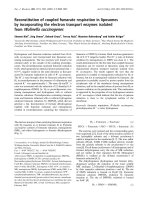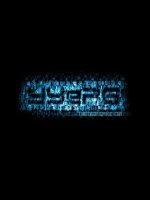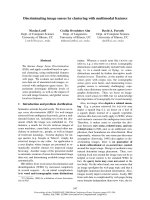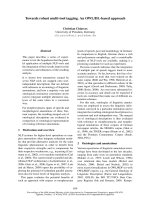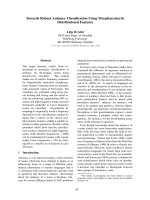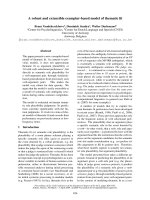Towards robust and accurate image registration by incorporating anatomical and appearance priors
Bạn đang xem bản rút gọn của tài liệu. Xem và tải ngay bản đầy đủ của tài liệu tại đây (1.97 MB, 165 trang )
Towards Robust and Accurate Image Registration
by Incorporating Anatomical and Appearance
Priors
LU YONGNING
(B. Eng., National University of Singapore)
A thesis submitted for the degree of
Doctor of Philosophy
NUS Graduate School for Integrative Sciences and Engineering
NATIONAL UNIVERSITY OF SINGAPORE
2014
Declaration
I hereby declare that the thesis is my original
work and it has been written by me in its entirety.
I have duly acknowledged all the sources of
information which have been used in the thesis.
This thesis has also not been submitted for any
degree in any university previously.
Signed:
LU YONGNING
Date:
i
This thesis is dedicated to
all the people – who never stopped having faith in me
my parents – who raised me and supported my
education, for your love and sacrifices
my wife – who is so understanding and supportive
along the journey
my friends – whom I am so grateful to have in my life
iii
Acknowledgements
I would like to thank all my supervisors, Assoc. Prof. Ong Sim
Heng, Dr. Sun Ying, Dr. Liao Rui, Dr. Zhang Li and members of
my Thesis Advisory Committee – Prof. Ge Shuzhi, Assoc. Prof.
Lee Chi Hang, for their guidance and support, without which my
research would not be guided so well and carried out smoothly.
I would like to thank Mr. Francis Hoon, laboratory officer at Vi-
sion and Machine Learning Laboratory, for the assistance during
my PhD study. Special thanks to my friends and colleagues in the
lab Dr. Ji Dongxu, Dr. Wei Dong, Dr. Cao Chuqing, for your
encouragement and company along my PhD journey.
I would also like to thank Siemens Corporate Research and Tech-
nology, for offering an internship opportunity to me. I have been
enlightened during the internship for both the academic work and
life.
Finally, I would like to thank NUS Graduate School for Integrative
Sciences and Engineering (NGS) for awarding me the NGS Schol-
arship. Many thanks goes to the directors, mangers and staff at NGS
for their help and support.
v
Summary
Image registration is one of the fundamental computer vision prob-
lems, with applications ranging from motion modeling, image fu-
sion, shape analysis, to medical image analysis. The process finds
the spatial correspondences between different images that may be
taken at different time or by modalities of acquisition. Recently, it
has been shown that incorporating prior knowledge into the regis-
tration process has the potential to significantly improve the image
registration results. Therefore, many researchers have been putting
lots of effort in this field.
In this thesis, we investigate the possibility of improving the robust-
ness and accuracy of image registration, by incorporating anatom-
ical and appearance priors. We explored and formulated several
methods to incorporate anatomical and appearance prior knowledge
into image registration process explicitly and implicitly.
To incorporate the anatomical prior, we propose to utilize the seg-
mentation information that is readily available. An intensity-based
similarity measure named structural encoded mutual information
is introduced by emphasizing the structural information. Then we
use registration of the anatomical-meaningful point sets that are ex-
tracted from the surface/contour of the segmentation to generate an
vii
anatomical meaningful deformation field. The two types of data-
driven prior information are then combined in a hybrid manner to
jointly guide the image registration process. The proposed method
is fully validated in a pre-operative CT and non-contrast-enhanced
C-arm CT registration framework for Trans-catheter Aortic Valve
Implantation (TAVI) and other applications.
To incorporate the appearance prior, we proposed to describe the
intensity matching information by using normalized pointwise mu-
tual information which can be learnt from the training samples. The
intensity matching information is then incorporated into the image
registration framework by introducing two novel similarity mea-
sures, namely, weighted mutual information and weighted entropy.
The proposed similarity measures have demonstrated their wide ap-
plicability ranging from natural image examples to medical images
from different applications and modalities.
Lastly, we explored the feasibility of generating different image
modalities from one source image based on prior image matching
knowledge that is extracted from the database. The synthesized im-
ages based on prior knowledge can be then used for image registra-
tion. Using the synthesized images as the intermediate step in the
multi-modality registration process explicitly simplifies the prob-
lem to a single modality image registration problem.
The methods and techniques we proposed in this thesis can be com-
bined and/or tailored for any specific applications. We believe that
viii
with more population databases made available, incorporating prior
knowledge can become an essential component to improving the
robustness and accuracy of image registration.
ix
Contents
List of Figures
xv
1 Introduction 1
1.1 Image Registration: An Overview . . . . . . . . . . . . . . . . 1
1.2 Thesis Organization and Contributions . . . . . . . . . . . . . . 4
2 Background 8
2.1 Introduction . . . . . . . . . . . . . . . . . . . . . . . . . . . . 8
2.2 Transformation Models . . . . . . . . . . . . . . . . . . . . . . 9
2.2.1 Global Transformation Models . . . . . . . . . . . . . . 10
2.2.1.1 Rigid Transformations . . . . . . . . . . . . . 10
2.2.1.2 Affine Transformations . . . . . . . . . . . . 12
2.2.2 Local Transformation Models . . . . . . . . . . . . . . 13
2.2.2.1 Transformations derived from physical models 13
2.2.2.2 Transformations based on basis function ex-
pansions . . . . . . . . . . . . . . . . . . . .
17
2.2.2.3 Knowledge-based transformation models . . . 21
2.3 Matching Criterion . . . . . . . . . . . . . . . . . . . . . . . . 22
xi
CONTENTS
2.3.1 Feature-Based . . . . . . . . . . . . . . . . . . . . . . 23
2.3.1.1 Feature Points Detection . . . . . . . . . . . . 23
2.3.1.2 Transformation Estimation based on Feature
Points . . . . . . . . . . . . . . . . . . . . . 23
2.3.2 Intensity-Based . . . . . . . . . . . . . . . . . . . . . . 24
2.3.2.1 Mono-modal Image Registration . . . . . . . 25
2.3.2.2 Multi-modal Image Registration . . . . . . . 26
2.3.3 Hybrid . . . . . . . . . . . . . . . . . . . . . . . . . . 28
2.3.4 Group-wise . . . . . . . . . . . . . . . . . . . . . . . . 29
2.4 Conclusions . . . . . . . . . . . . . . . . . . . . . . . . . . . . 30
3 Image Registration: Utilizing Anatomical Priors 31
3.1 Introduction . . . . . . . . . . . . . . . . . . . . . . . . . . . . 31
3.2 Dense Matching and The Variational Framework . . . . . . . . 33
3.3 Method . . . . . . . . . . . . . . . . . . . . . . . . . . . . . . 35
3.3.1 Anatomical Knowledge-based Deformation Field Prior . 35
3.3.1.1 Penalty from Prior Deformation Field . . . . . 38
3.3.2 Similarity Measure for Deformable Registration . . . . 39
3.3.2.1 Structure-Encoded Mutual Information . . . . 40
3.3.3 Optimization . . . . . . . . . . . . . . . . . . . . . . . 42
3.4 Experiments . . . . . . . . . . . . . . . . . . . . . . . . . . . . 43
3.4.1 Pre-operative CT and Non-contrast-enhanced C-arm CT 44
3.4.1.1 QualitativeEvaluation on Artificial Non-Contrast
Enhanced C-arm CT . . . . . . . . . . . . . . 45
xii
CONTENTS
3.4.1.2 Qualitative Evaluation on Real Non-Contrast
Enhanced C-arm CT . . . . . . . . . . . . . .
52
3.4.2 Myocardial Perfusion MRI . . . . . . . . . . . . . . . . 54
3.4.2.1 Experimental Setup. . . . . . . . . . . . . . . 54
3.4.2.2 Experiment Results . . . . . . . . . . . . . . 54
3.4.3 Simulated Pre- and Post- Liver Tumor Resection MRI . 56
3.4.3.1 Experimental Setup . . . . . . . . . . . . . . 57
3.4.3.2 Results . . . . . . . . . . . . . . . . . . . . . 57
3.5 Conclusion . . . . . . . . . . . . . . . . . . . . . . . . . . . . 58
4 Multi-modal Image Registration: Utilizing Appearance Priors 59
4.1 Introduction . . . . . . . . . . . . . . . . . . . . . . . . . . . . 59
4.2 Method . . . . . . . . . . . . . . . . . . . . . . . . . . . . . . 61
4.2.1 Normalized Pointwise Mutual Information . . . . . . . 61
4.2.2 Weighted Mutual Information . . . . . . . . . . . . . . 64
4.2.2.1 Formation of WMI . . . . . . . . . . . . . . 64
4.2.2.2 Probabilistic Interpretation Using Bayesian In-
ference . . . . . . . . . . . . . . . . . . . . .
66
4.2.2.3 Optimization of Variational Formulation . . . 68
4.2.3 Weighted Entropy of Intensity Mapping Confidence Map 69
4.2.3.1 Intensity Matching Confidence Map . . . . . 69
4.2.3.2 Weighted Entropy . . . . . . . . . . . . . . . 72
4.2.3.3 Optimization of Variational Formulation . . . 74
4.3 Experiments . . . . . . . . . . . . . . . . . . . . . . . . . . . . 75
4.3.1 Synthetic Image Study . . . . . . . . . . . . . . . . . . 75
xiii
CONTENTS
4.3.2 Face Images with Occlusion and Background Changes . 77
4.3.3 Simulated MRIs . . . . . . . . . . . . . . . . . . . . . 81
4.3.3.1 Similarity Measure Comparison . . . . . . . . 81
4.3.3.2 Deformable Registration Evaluation . . . . . 84
4.4 Conclusion . . . . . . . . . . . . . . . . . . . . . . . . . . . . 89
5 Modality Synthesis: From Multi-modality to Mono-modality 91
5.1 Introduction . . . . . . . . . . . . . . . . . . . . . . . . . . . . 92
5.2 Method . . . . . . . . . . . . . . . . . . . . . . . . . . . . . . 94
5.2.1 Database Reduction . . . . . . . . . . . . . . . . . . . 95
5.2.2 Modality Synthesis . . . . . . . . . . . . . . . . . . . . 96
5.2.2.1 Locality Search Constraint . . . . . . . . . . 96
5.2.2.2 Modality Synthesis Using a Novel Distance
Measure . . . . . . . . . . . . . . . . . . . .
97
5.2.2.3 Search in Multi-Resolution . . . . . . . . . . 99
5.3 Experiments . . . . . . . . . . . . . . . . . . . . . . . . . . . . 100
5.3.1 Synthetic Image Study . . . . . . . . . . . . . . . . . . 100
5.3.2 Synthesis of T2 from T1 MRI . . . . . . . . . . . . . . 102
5.4 Conclusion . . . . . . . . . . . . . . . . . . . . . . . . . . . . 106
6 Conclusion and Future Work 107
6.1 Incorporating Anatomical Prior . . . . . . . . . . . . . . . . . . 107
6.2 Incorporating Appearance Prior . . . . . . . . . . . . . . . . . 108
6.3 Modality Synthesis . . . . . . . . . . . . . . . . . . . . . . . . 110
7 Publication List 111
xiv
CONTENTS
References 115
xv
List of Figures
3.1 Structure appearance may be largely different due to different
levels of contrast-enhancement. (a) and (b) is a pair of images
from pre-operative contrast-enhanced CT and intra-operative non-
contrast-enhanced C-arm CT for TAVI procedure. (c) and (d) is
a pair of images from a perfusion cardiac sequence at different
phases. . . . . . . . . . . . . . . . . . . . . . . . . . . . . . . .
32
3.2 Pre-operative CT, intra-operative contrast-enhanced C-arm CT
and Simulated non-contrast-enhanced C-arm CT image exam-
ples from two patients. Column (a): Pre-operative CT. Column
(b): Intra-operative contrast-enhanced C-arm CT. Column (c):
Simulated non-contrast-enhanced C-arm CT. . . . . . . . . . . .
45
3.3 Registration performance of 20 patients measured using mesh-
to-mesh error. . . . . . . . . . . . . . . . . . . . . . . . . . . .
46
xvi
LIST OF FIGURES
3.4 Point sets extracted from the aortic root surface, before (left) and
after (right) deformable registration. Red point set is the ground
truth, and blue point sets are extracted from pre-operative CT.
The black arrows demoindicate the errors calculated at the three
corresponding points. . . . . . . . . . . . . . . . . . . . . . . .
47
3.5 The registration results from Patients 5 (Row 1) and 9 (Row 2).
(a) Rigid. (b) Deformable using MI. (c) Directly applying prior
deformation field. (d) Lu’s method (e) The proposed method.
The red lines delineate the aortic root, the green lines delineate
the myocardium and the yellow lines delineate the other visible
structures from the CT images. . . . . . . . . . . . . . . . . . 48
3.6 The left and right coronary ostia at the aortic valve of two exam-
ple data: (a) C-arm CT image (b) Pre-operative CT image. The
table on the right shows the landmark registration error between
the registered coronary ostia in the CT image to the correspond-
ing points in the C-arm CT image. The mean, standard devia-
tion (STD), and median of the errors are reported (measured in
millimeters). . . . . . . . . . . . . . . . . . . . . . . . . . . . 51
3.7 Qualitative evaluation on image registration of CT and real non-
contrast enhanced C-arm CT. Row 1: Non contrast-enhanced
C-arm CT. Row 2: After rigid-body registration. Row 3: After
deformable registration. . . . . . . . . . . . . . . . . . . . . .
53
3.8 Quantitative comparison of the registration errors (in pixel) ob-
tained by rigid registration, MI, SMI and the proposed method. .
55
xvii
LIST OF FIGURES
3.9 Registration results (a) Rigid (b) Simple warping using segmen-
tation information (c) SMI (d) Proposed method. Yellow and
blue lines are the propogated and the ground truth contour. . . .
56
3.10 (a) Pre-operative MRI. (b) Simulated post-operative MRI. (c),
(d) and (e) are the registration results using simple warping, SMI
and our method respectively. . . . . . . . . . . . . . . . . . . .
57
4.1 Two corresponding PD/T1 brain MRI slices and the computed
NPMI. The red value shown in the NPMI map shows high cor-
relation between the intensity pairs. . . . . . . . . . . . . . . .
62
4.2 Different training slices may result in different joint histograms
but similar intensity matching relationship. (a) (b) A training
pair of brain image (T1/PD). (c) (d) another training pair of
brain image. (e) (f) the resulting learnt joint histograms from
pair (a) (b) and (c) (d) respectively. (g) (h) the resulting learnt
intensity matching prior from pair (a) (b) and (c) (d) respectively. 63
4.3 (a)Intensity matching confidence map before image registration,
the black area indicates low matching confidence which is a sign
of mis-alignment. (b)Intensity matching confidence map after
registration where high matching confidence value is across the
map. (c) NPMI obtained from the training data set. (d) Training
images. . . . . . . . . . . . . . . . . . . . . . . . . . . . . . .
72
xviii
LIST OF FIGURES
4.4 (a) Target image. (b) Source image. (c) Contour of the source
image overlaid onto the reference image before registration. (d)
Registration result using MI. (e) (f) Registration result using the
proposed method with different matching profiles. For (d) (e)
(f), green line indicates the contour of the source image after
registration. . . . . . . . . . . . . . . . . . . . . . . . . . . . . 76
4.5 (a) Target image. (b) Source image. (c) Contour of the source
image overlaid onto the target image before registration. (d)
Registration result using the method in [
105]. (e) Registration
result using the proposed method. In (d) (e), green line indicates
the contour of the source image after registration. . . . . . . . .
77
4.6 Face images used for training and registration. (a) (b), training
images. (c) (d) target and source images used for registration,
with the addition of the different backgrounds. . . . . . . . . . .
78
4.7 Three different backgrounds are tested during registration. (a)
(b) (c) overlay the edge of the source image to the target im-
age before registration. (d) (e) (f) show the result obtained by
conventional mutual information. (g) (h) (i) show the result ob-
tained by the method proposed in [
105]. (j) (k) (l) show the
result obtained by using WMI. And (m) (n) (o) show the result
obtained by using weighted entropy . . . . . . . . . . . . . . .
80
4.8 Plot of three similarity measures (MI, WMI and weighted en-
tropy with an accurate NPMI) with respect to the translational
and rotational shift. Zero translation and rotation corresponds to
the perfect alignment. . . . . . . . . . . . . . . . . . . . . . . .
82
xix
LIST OF FIGURES
4.9 Plot of three similarity measures (MI, WMI and weighted en-
tropy with less accurate NPMI) with respect to the translational
and rotational shift. Zero translation and rotation corresponds to
the perfect alignment. . . . . . . . . . . . . . . . . . . . . . . .
83
4.10 Quantitative comparison of the registration results obtained by
conventional MI, WMI and the proposed weighted entropy by
applying ten randomly created deformation fields using TPS.
Accurate intensity matching prior information is used. . . . . . .
85
4.11 Qualitative comparison of the registration results of the MR
brain images obtained by (a) conventional MI, (b) WMI and
(c) the proposed weighted entropy. Accurate intensity matching
prior information is used. The major differences of the registra-
tion results are indicated by the arrows. . . . . . . . . . . . . .
86
4.12 Quantitative comparison of the registration results obtained by
conventional MI, WMI and the proposed weighted entropy by
applying ten randomly created deformation fields using TPS.
Shifted intensity matching prior information is used. . . . . . .
87
4.13 Qualitative comparison of the registration results of the MR
brain images obtained by (a) conventional MI, (b) WMI and (c)
the proposed weighted entropy. Shifted intensity matching prior
information is used. The purple circle indicates the area where
large misalignment occurs for MI and WMI. . . . . . . . . . . .
88
xx
LIST OF FIGURES
5.1 NPMI training example, using a pair of T1/T2 brain MR images.
(a) T1 image (b) Corresponding aligned T2 image (c) Obtained
NPMI. . . . . . . . . . . . . . . . . . . . . . . . . . . . . . . .
99
5.2 (a) Training Image Modality A (b) Training Image Modality B
(c) Source Image Modality A (d) Synthesized Target Image us-
ing [
113]’s method (e) Synthesized Target Image using the pro-
posed method. . . . . . . . . . . . . . . . . . . . . . . . . . . .
101
5.3 Correlation coefficients between synthesis T2 and the ground
truth T2 computed by proposed method (with full database)
(green), proposed method (with the reduced database) (red) and
[
113]’s method (with full database) (blue). . . . . . . . . . . . . 103
5.4 Visual results for synthesis of T2 from different data sets. Col
(a) Input Images from T1 (b) Synthesis of T2 using [113](c)
Synthesis of T2 using the proposed method (d) Ground truth T2
images. . . . . . . . . . . . . . . . . . . . . . . . . . . . . . .
105
xxi
Chapter 1
Introduction
1.1 Image Registration: An Overview
In the field of image processing, it is often important to spatially align the images
taken from different instants, from different devices, or different perspectives,
so as to perform further qualitative and quantitative analysis of the images. The
process of spatially aligning the images, is called image registration. More pre-
cisely, the goal of image registration is to find an optimal spatial transformation
that maps the target image to the source image. From a mathematical perspec-
tive, given two input images, namely the source and target images, the image
registration process is an optimization problem that finds the geometric trans-
formation that brings the source image to be spatially aligned with the target
image. The types of geometric transformation depends on the specific appli-
cation. Generally, the transformation can be divided into two groups – global
and local. The selection of the transformation model is highly dependent on the
application.
1
1.1 Image Registration: An Overview
As a fundamental computer vision problem, image registration has a wide
range of applications, including motion modeling, image fusion, shape analysis,
and medical image analysis. Detailed surveys and overviews on applications of
image registration can be found in [
1], [2], [2], [3], [4], [5], [6] and [7]. In this
thesis, we will mainly focus on but not limited to deformable medical image
registration, although the proposed methods can be straightforwardly applied to
other applications, which we will also demonstrate in this thesis.
Image registration helps the clinicians to interpret the image information ac-
quired from different modalities, different time points, or pre- and post- contrast-
enhancement. Combining the image information from different time instants
helps the clinicians to examine the disease progression over time. As the imag-
ining technology develops, there are more and more imaging modalities that
provide spatial co-localization of complementary information, including struc-
tural and functional information. These image modalities can be generally clas-
sified as either anatomical or functional [
8, 9, 10]. Morphological information
is explicitly depicted in the anatomical modalities, which include CT (computed
tomography), MRI (magnetic resonance imaging), X-ray, US (ultrasound), etc.
Metabolic information on the target anatomy is emphasized in the functional
modalities, which include scintigraphy, PET (position emission tomography),
SPECT (single photon emission computed tomography), and fMRI (functional
MRI). Complementary information from different imaging modalities makes
the assessment to be more convenient and accurate for the clinicians. With
the rapid development of the clinical assessment technique and imaging tech-
niques, medical applications increasingly rely more on the image registration;
such applications range from examination of disease progression to the usage
2

